Is a ukulele different from a guitar? Of course it is, you can see the difference between a ukulele and a guitar just by looking at it. Ukulele vs guitar in a nutshell? There are differences in terms of size, tuning, string types, chord shapes, sound quality and price.
1. Ukulele vs guitar: different size
The most obvious difference between a guitar and ukulele is size. On average, ukuleles are around 35% to 50% smaller than most guitars. The size difference between a ukulele and guitar affects the volume, tone, and playability of the two instruments. I will talk about these areas in more detail below.

The image below compares a soprano, concert, and tenor ukulele to a dreadnought guitar, which is the most common acoustic guitar size. I will discuss the baritone uke towards the end of the article. The exact size differences between the ukulele and guitar will vary depending on the manufacturer, but they’ll be pretty close to what you see here.
2. Number of strings
The number of strings is another obvious difference between the ukulele and guitar, but it’s also one of the most important. Most guitars have six strings, while most ukuleles have four. Since a ukulele has two fewer strings than a guitar, many people consider it a less difficult instrument to learn.
Fewer strings also mean there are plenty of simple one and two-finger chords. These easy chords give new players a helpful “fast track” into the world of stringed instruments and allow them to start making music quickly.
Both guitars and ukuleles exist in alternative string configurations such as 12-string guitars and 8-string ukuleles. However, the majority of guitars and ukes will have the standard 6 and 4-string configurations mentioned above.
3. Types of ukulele or guitar strings
Here’s a short rundown of the differences between the strings used on guitars and ukuleles:
GUITAR STRINGS
- Made of metal (usually)
- High tension
- Loud, bright tone
UKULELE STRINGS
- Made of nylon or similar flexible, synthetic material
- Low tension
- Softer, warmer tone
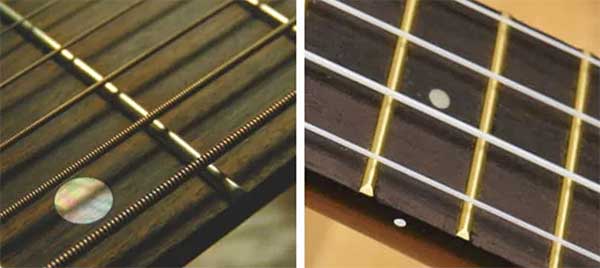
For the most part, uke strings are softer and stretchier, and they have less of a “tight” feeling than guitar strings.
This is one of the reasons that the uke is often viewed as a more comfortable instrument to play than the guitar. It’s also part of the reason ukuleles tend to have a warmer, more delicate tone. Ukuleles tuned to a low G usually have one metal string. This string is made of a thin core of synthetic thread with a metal winding, much like a guitar string.
4. Tuning differences (and similarities) ukulele vs guitar
These are the notes for standard ukulele vs guitar tunings:
- A ukulele is tuned G-C-E-A
- A guitar is tuned E-A-D-G-B-E
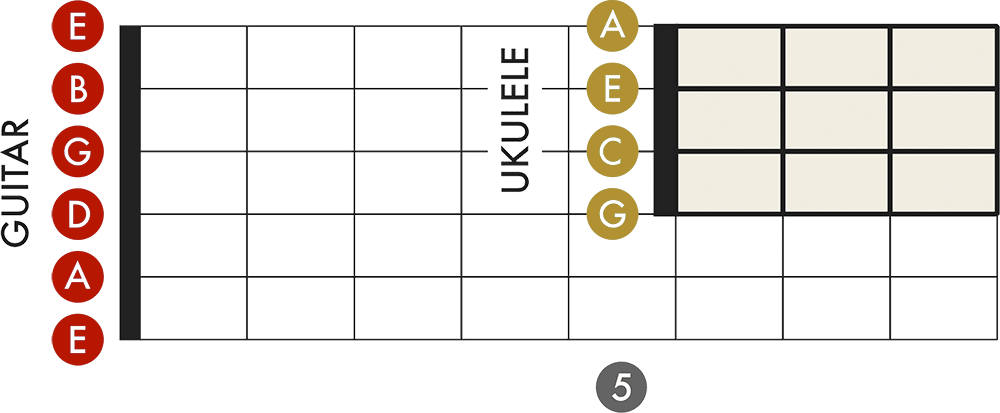
The ukulele and guitar are tuned differently, but they are still related. If you put your finger (or a capo) across the four highest-pitched strings on a guitar at the fifth fret, you’ll get the notes of a ukulele. In other words, a ukulele is like the top four strings of a guitar, but tuned up a fourth.
The image below shows the relationship between a guitar and ukulele fretboard. The green section shows where the notes of a guitar and ukulele overlap.
If you’re using standard ukulele tuning, the ukulele’s G string is tuned up an octave. If you’re using low-G tuning, the notes are exactly the same as the top four guitar strings at the fifth fret.
SIMILAR CHORD SHAPES
These tuning similarities mean that many chord shapes are the same on both instruments.
Some guitar chords work fine on a ukulele, like a D guitar chord. Playing this shape on a ukulele results in a G chord, which is a fourth higher.
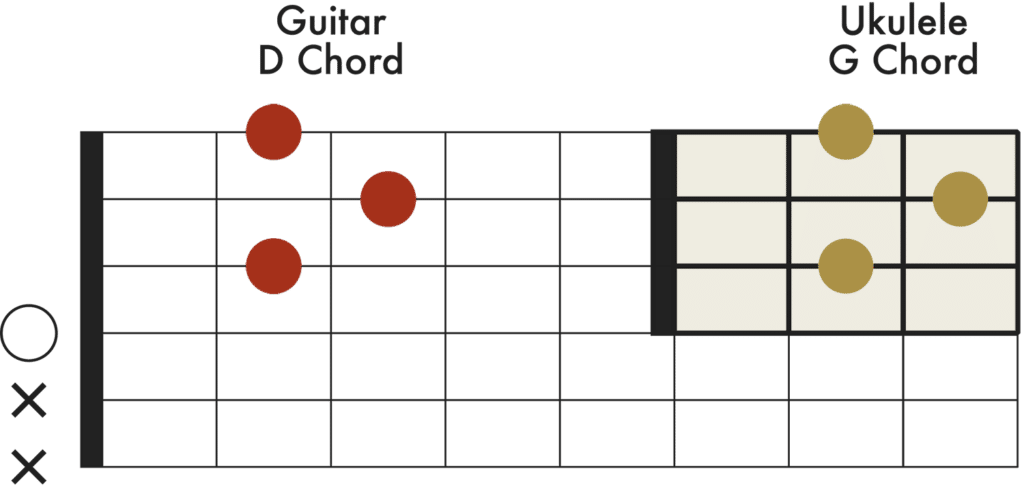
For guitar chords that include the low E or A, you can often just use the same shape but remove the bottom two guitar strings.
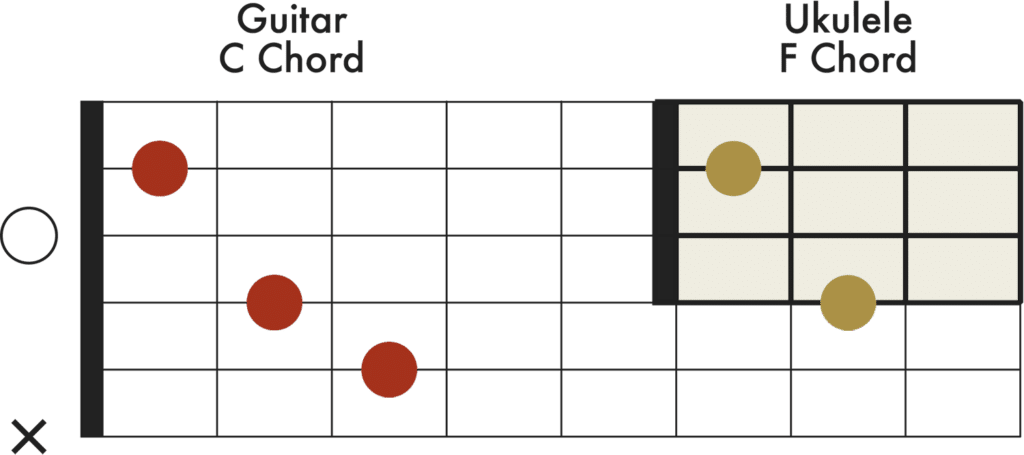
Sometimes taking out the bottom two strings of a guitar chord removes important notes in the chord. Transferring a guitar shape directly to the ukulele can result in a chord that isn’t as well defined and may not sound the way you expect it to.
5. String tension
String tension is a measure of the “tightness” or “looseness” of the strings on an acoustic instrument, in this case the ukulele or guitar:
- Ukulele string tension is around 7 lbs to 13 lbs per string
- Guitar string tension is around 24 lbs to 35 lbs per string
As you can see, the string tension of a guitar is roughly three times that of a ukulele. Instruments with high string tension usually sound louder and brighter, but the tightness of the strings makes them harder to play. On the other hand, low-tension instruments are easier to play but aren’t capable of producing as much volume.
6. Ukulele vs guitar: sound differences
A big difference of ukulele vs guitar is the tone. However, there are so many variables in an instrument’s construction that it’s impossible to offer a one-size-fits-all explanation. Factors like tonewood, body size, and manufacturer all affect tone in ways that can be hard to quantify and describe. With that in mind, these brief descriptions should give you a basic idea of what to expect.
GUITAR TONE QUALITIES
In general, guitars are louder, brighter, and have more bass than ukuleles. This is mainly due to the guitar’s bigger body, larger pitch range and high-tension steel strings. Guitars are often played with a pick, which results in even more volume and brightness.
UKULELE TONE QUALITIES
Compared to the guitar, ukuleles have a quieter, mellower, tone that’s more treble-focused. I’ve seen people describe a ukulele’s tone as gentle, sweet, or harp-like. These characteristics are mainly due to their smaller bodies, soft strings, and low string tension. Classical (nylon-string) guitars have a tone that is similar to a ukulele, but with the added volume and bass of a guitar.
7. Scale length
On a stringed instrument, the scale length is the distance between the nut and the saddle. It’s the section of the strings that vibrates when you play.
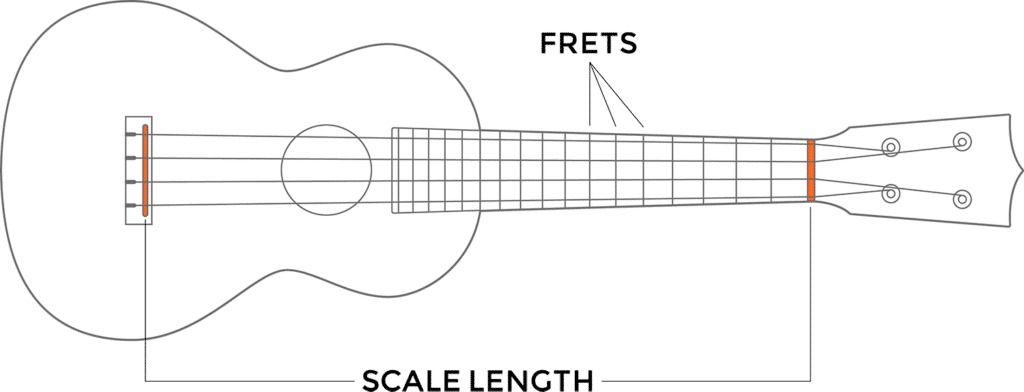
If we compare the ukulele vs guitar, a ukulele’s scale is 25% to 50% shorter than a guitar, which means that the frets are closer together on a ukulele. Closer frets mean that players don’t have to stretch as far to form chords. This is ideal for children, folks with smaller hands, or anybody who wants an instrument that’s comfortable and easy to play. Scale length also relates to string tension. Shorter scales typically have lower string tension than longer scales.
8. Price
Price doesn’t come up often when discussing the differences between ukulele and guitar, but it’s worth mentioning. You can buy a good beginner ukulele for $100. This might seem like a lot, but in the realm of acoustic instruments it’s actually pretty cheap. A decent beginner guitar (by my standards) is going to cost a bare minimum of $200, and guitars in this price range often need adjustments and setup work before they’ll play comfortably.
If you’re on a budget or looking for an instrument for a child, I think it makes more sense to buy a good uke for under $100 instead of a so-so guitar for over $200.
9. Baritone ukulele or guitar
Baritone ukuleles are the largest of the four primary ukulele sizes, with a total length of around 26″.

Unlike the other three sizes of ukulele (soprano, concert and tenor), a baritone ukulele is tuned exactly like the top four strings of a guitar: D-G-B-E. In other words, a baritone ukulele is like a guitar without the two lowest strings (E and A). This means many guitar chords translate directly to a baritone uke, but as I warned earlier, some guitar chords won’t sound right without those bottom two strings. The baritone uke’s similarities to the guitar make it a natural second instrument for many guitar players.
10. Ukulele vs guitar: which is easier to learn?
The ukulele is generally easier to learn than the guitar and more accessible to new players. I’ve already touched on most of the reasons in previous sections, but here’s a quick rundown:
- Soft, low-tension strings: easier on fingers
- Fewer strings: less intimidating, simpler chords, faster initial progress
- Shorter scale: shorter distance between frets, less stretching required
- Small size: more kid-friendly than most guitars
- Similar tuning to guitar: easy to transition to guitar later on
While there’s no substitute for practice and dedication, the uke has fewer potential learning roadblocks. In my experience, players with no previous experience progress more quickly on a uke, which leads to more enjoyment and more time spent playing.
Of course, if you want to learn the guitar vs ukulele, go for it! There’s nothing wrong with starting on a guitar if that’s what you really want to play. Just keep in mind that the learning curve is a little steeper on the guitar.
Need more input?
I hope this guide has helped you to find out more about the differences between a ukulele and a guitar? Can you make a decision now?
5 Frequently Asked Questions comparing ukulele and guitar
Yes, many chord shapes transfer nicely if you drop or ignore the extra strings. For example, shapes using the top four guitar strings often map over to a ukulele tuning. Just be aware that without the two lowest guitar strings, some chords lose depth or bass that you’d get on a full guitar.
Usually the ukulele is easier for most beginners. It has fewer strings, lower tension, shorter scale length (so your fingers don’t need to stretch as far), and softer, more forgiving strings. All that means quicker progress and fewer sore fingers early on.
Guitars offer wider tonal range, more bass, louder volume, and more complex chord options. But trade-offs include extra size, more strings to manage, higher tension strings, and often a steeper learning curve for basic chords and finger stretches.
Absolutely. Skills like fretboard awareness, strumming patterns, rhythm, and ear training carry over. Also, certain tunings are related (for instance, the top four strings of a guitar correspond in pitch to a ukulele’s tuning when using a capo). Starting with uke can make some transitions to guitar smoother.
If you want louder sound, deeper bass, broader chord voicings (especially low bass notes), or plan to play music styles that rely on guitar techniques (e.g. lead guitar, fingerstyle bass lines), then a guitar might suit you better. Also, if you expect to play with others or in big spaces, a guitar projects more.
Feel free to contact me whenever you need more information about the difference between a ukulele and guitar.
